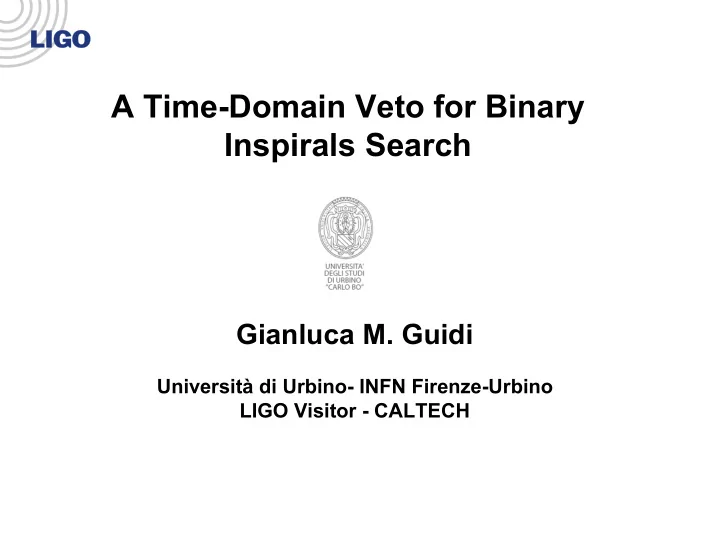

A Time-Domain Veto for Binary Inspirals Search Gianluca M. Guidi Università di Urbino- INFN Firenze-Urbino LIGO Visitor - CALTECH
A Time-Domain Veto for Binary Inspirals search The distinction between actual gravitational waves from binary inspirals and false noise triggers with the same SNR and χ 2 frequency distribution needs the implementation of a Veto which operates in the time domain.
The correlator and its statistic distribution The Gaussian variables x(t) and y(t) are the correlation between the ITF output h(t) and the cosine and sine polarizations of the inspiral signal: � � � � ∞ ∞ * * h f h ( ) ( ) f = ∫ h f h ( ) ( ) f = ∫ π π 2 ift 2 ift y t ( ) 2 e s df x t ( ) 2 e c df ( ) ( ) S f S f −∞ h −∞ h The statistic normally considered is: � � ∞ ( ) ( ) * h ( ) f h ( ) f df = ∫ + 2 2 x t y t σ 2 c c 2 ( ) with: ρ = ( ) 2 t S f σ 2 −∞ h In absence of signal ρ 2 (t) has a χ 2 distribution.
The correlator and its statistic distribution ( ) ( ) ( ) ( ) 2 2 When a signal has been detected, − + − x t x t ( ) y t y t ( ) � ( ) ρ = χ = 2 2 t we can consider the statistic: σ 2 n 2 � � ∞ * = ∫ h ( ) f h ( ) f is the mean of x(t) for cosine component π 2 ift Where x t ( ) 2 e c c df ( ) of the template that has matched the signal. S f −∞ h Simulated data � ρ ρ 2 ( ) 2 ( ) t t
Two Possible Time-Domain Vetoes � ρ 2 1) Analysis of the probalility that N � ρ uncorrelated values of exceed a fixed 2 threshold before the time of coalescence. � ρ 2 2) Analysis of the probability that the max over a time T exceeds a fixed threshold before the time of coalescence.
1-Crossing Veto We consider N uncorrelated times before the coalescence. t t t t coalescence − .. .. N 1 N δ ≥ t 1 4 f a ( ) � Thr 2 ρ ( ) Probability that the statistic at t i i = ∫ � ( � ) � Thr ( � ) Thr ρ < ρ χ ρ 2 2 2 2 P t d ρ does not exceed : 2 = i i n 2 i 0 ( ) N � � ( ) Probability that anyone of the N ∏ Thr = P t ρ < ρ 2 2 P values exceeds the thresholds: tot i i = i 1
1-Crossing Veto Probability that the thresholds are = − P 1 P tot exceeded at least one time: ) ( � � ( ) Thr ρ < ρ = ∀ = 2 2 P t p , i 1, N If we suppose that: i i ( ) 1 � � ( ) Thr = N P p ρ < ρ = 2 2 P t P N tot i i tot � Ex: We fix N =10 and choose a ρ 2 P confidence level of 5% ( = 0.05) ) ( � ( � ) 1 Thr ( ) P t ρ < ρ = = 2 2 0.95 0.995 10 i i ( � ) Thr ρ 2 = 10.55 i
1-Crossing Veto Monte Carlo with 7 < SNR < 20 – simulated LIGO noise. P P = 0.2 = 0.1 ( � ) � ( ) Thr Thr ρ 2 = ρ = 7.63 2 9.12 Number of crossing i i P P = 0.05 = 0.01 ( � ) � ( ) Thr Thr ρ 2 = ρ = 10.55 2 13.81 i i SNR
Veto on the Maxima � ρ 2 We choose an interval of time before the coalescence and find � ρ 2 the maximum of The distribution of the maxima follows a Fréchet distribution: � ρ 2 max − α − + α (1 ) x 1 − x σ = α f x ( ) e F σ σ F F = � ρ 2 x max
Veto on the Maxima We fix a cofidence level C and find: 1 − 1 ( � ) α Thr ρ = σ 2 ln 1 max F − C α and σ F are the location and shape parameters which can be − α x found from the mean and stdv − ( � ) σ = F x ( ) e ln ρ 2 of F max Threshold for C = 5%
Veto on the Maxima The threshold of 6.5 corresponds to a confidence level of C = 0.02% = � ρ x 10% 5% 1% max
Conclusions and Perspectives The two vetoes seems to work well and can be applied together to events which have triggered and passed the χ 2 frequency veto. They need to be applied to real data and tuned on the real noise to understand which types of non-stationarities can be vetoed and develop possible improvements. I acknowledge Albert Lazzarini and Flavio Vetrano for having made possible my stay at CALTECH, and Giancarlo Cella and Peter Shawhan for fruitful discussions.
Recommend
More recommend